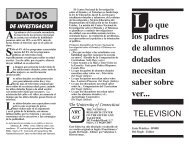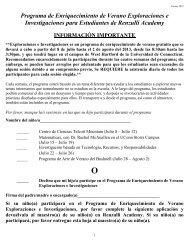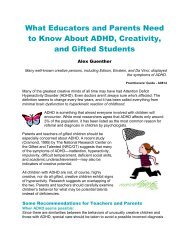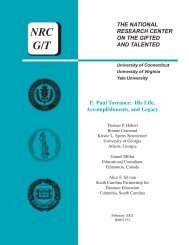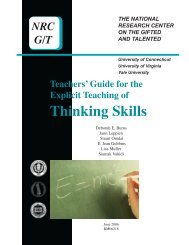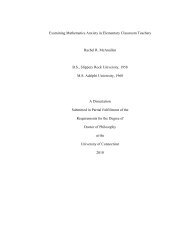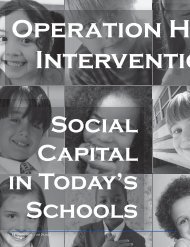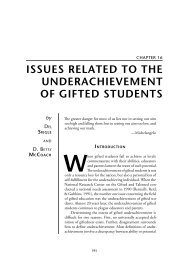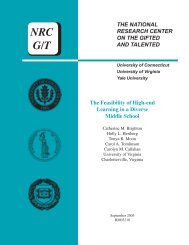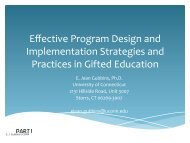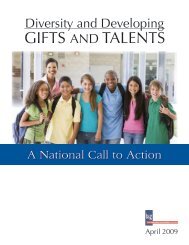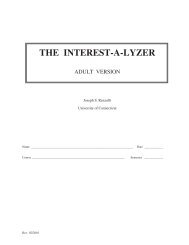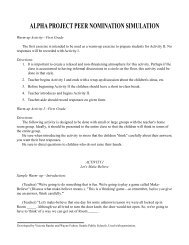Giftedness and High School Dropouts - Neag Center for Gifted ...
Giftedness and High School Dropouts - Neag Center for Gifted ...
Giftedness and High School Dropouts - Neag Center for Gifted ...
You also want an ePaper? Increase the reach of your titles
YUMPU automatically turns print PDFs into web optimized ePapers that Google loves.
1. An individual who, according to the school (if the sample member<br />
could not be located), or according to the school <strong>and</strong> home, is not<br />
attending school (i.e., has not been in school <strong>for</strong> 4 consecutive<br />
weeks or more <strong>and</strong> is not absent due to accident or illness); or<br />
2. A student who has been in school <strong>for</strong> less than 2 weeks after a<br />
period in which he or she was classified as a dropout. (National<br />
<strong>Center</strong> <strong>for</strong> Education Statistics, 1996, p. 112)<br />
The variable that was used to define dropouts was "<strong>High</strong> <strong>School</strong> Completion<br />
Status (f3diplom)." Category 4 was considered as a dropout.<br />
1. <strong>High</strong> school graduate—if individual has received a high school<br />
diploma<br />
2. Received alternative credential—if individual has received a GED<br />
or received a certificate of attendance<br />
3. Still enrolled in high school—if individual is currently in high<br />
school or is working toward an equivalent<br />
4. Dropout—if individual is not a graduate or GED/certificate holder.<br />
(National <strong>Center</strong> <strong>for</strong> Education Statistics, 1996, p. 115)<br />
Method<br />
Research Design<br />
This study utilized data from the National Education Longitudinal Study of 1988<br />
(NELS:88), collected by the National <strong>Center</strong> <strong>for</strong> Education Statistics (NCES). The<br />
NELS:88 began in 1988 by collecting data on approximately 25,000 eighth graders<br />
including data from their parents, teachers, <strong>and</strong> school administrators. These data were<br />
then followed up at 2-year intervals in 1990, 1992, <strong>and</strong> 1994.<br />
To address the research questions, two studies were conducted using two different<br />
sources of data <strong>and</strong> samples. In Study 1, the Second Follow-up Dropout Questionnaire of<br />
NELS:88 was analyzed to obtain specific in<strong>for</strong>mation about gifted students who drop out<br />
of school. Only students who had dropped out of school completed this questionnaire;<br />
there<strong>for</strong>e, gifted <strong>and</strong> non-gifted students were compared. In Study 2, student<br />
questionnaire data were analyzed to examine personal <strong>and</strong> educational factors related to<br />
the decision by gifted students to drop out of school.<br />
Samples <strong>for</strong> Study 1 <strong>and</strong> Study 2<br />
The sample in this study is composed of the students who were eighth graders in<br />
1988 <strong>and</strong> participated in the base year through the third follow-up survey of NELS:88.<br />
The sample from Study 1 consists of dropouts who were not in an academic program<br />
leading to a high school diploma, had not received a GED by the spring 1992, <strong>and</strong><br />
completed the Second Follow-up Dropout Questionnaire. In this study, gifted students<br />
ix



